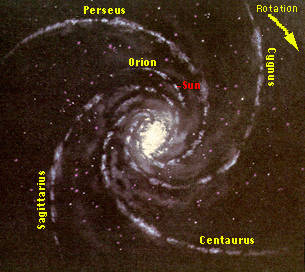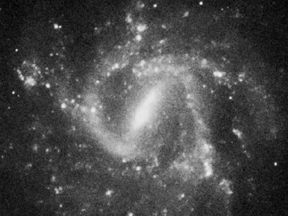![]()
Yes, the Sun - in fact, our whole solar system - orbits around the center of the Milky Way Galaxy. We are moving at an average velocity of 828,000 km/hr. But even at that high rate, it still takes us about 230 million years to make one complete orbit around the Milky Way!
The Milky Way is a spiral galaxy. We believe that it consists of a central bulge, 4 major arms, and several shorter arm segments. The Sun (and, of course, the rest of our solar system) is located near the Orion arm, between two major arms (Perseus and Sagittarius). The diameter of the Milky Way is about 100,000 light-years and the Sun is located about 28,000 light-years from the Galactic Center. You can see a drawing of the Milky Way below which shows what our Galaxy would look like "face-on" and the direction in which it would spin as viewed from that vantage point. Also shown, is the location of the Sun in the big picture view of our Galaxy.

It is interesting to note that recent observations by astronomers suggest that the Milky Way is in fact a "barred spiral galaxy", not just a "spiral galaxy". This means that rather than a simple spherical bulge of gas and stars at its center, it has instead a "bar of stars" crossing the central bulge. It might look something like the image shown below of the barred spiral galaxy known as NGC1073. But we still rotate around the center just the same!

![]()
The StarChild site is a service of the High Energy Astrophysics Science Archive Research Center (HEASARC), within the Astrophysics Science Division (ASD) at NASA/ GSFC.
StarChild Authors: The StarChild Team
StarChild Graphics & Music: Acknowledgments
StarChild Project Leader: Dr. Laura A.
Whitlock
Curator:
Responsible NASA Official: